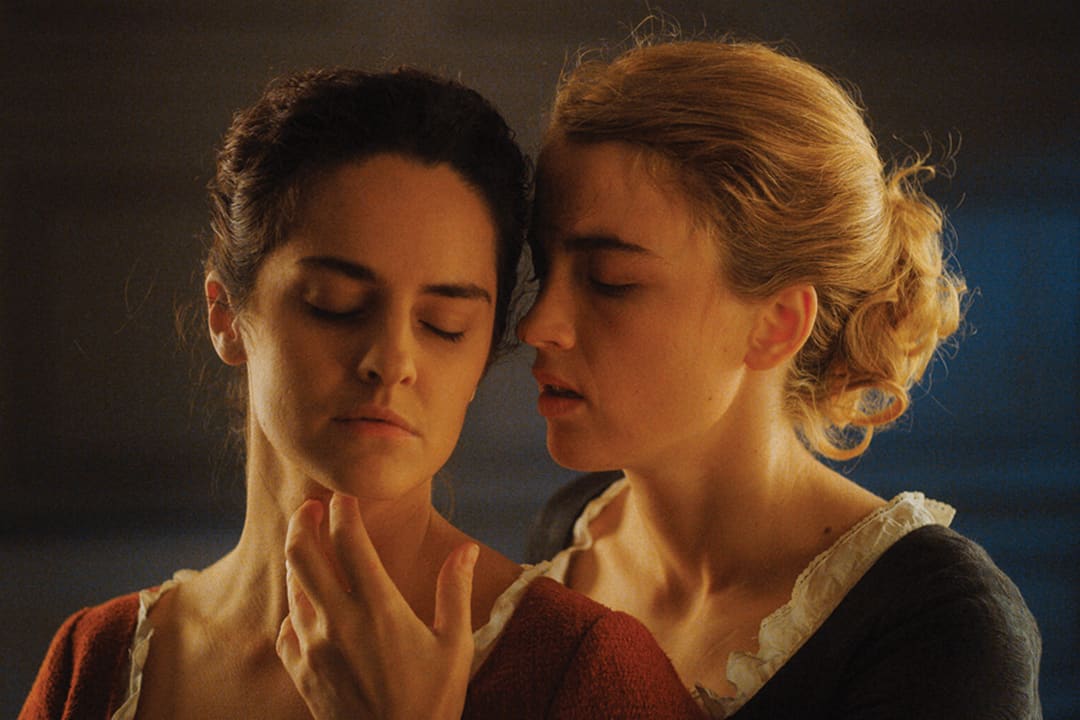Right before the screening of Portrait of a Lady on Fire began, director Céline Sciamma did two things. First, she commended the décor of the Elgin and Winter Garden Theatre, which has vines and bushels of fake shrubbery completely covering its ceiling, and second, she expressed her nerves at the buzz her movie had been generating. Leaning casually against the podium, she emphasized the relationship between such a grand, ornate theatre and her movie — a movie which was relatively small and didn’t have any big actors, though it may very well produce them — and commented on the fact that though this discrepancy was incredibly humbling, it was also very stressful.
Her stress, however, proved to be unfounded, as once the screen faded to black and the final credits rolled, everyone in the multi-tiered balconies shot up to give Sciamma and her cast a roaring ovation. Two hours of movie played in between her first appearance on stage and her second. Two hours of a movie where the delicate strings that connect lovers and friends are frayed and pulled at, though never completely severed.
The film begins with a brush stroke: a thick brush swipes dark paint on a canvas and we find ourselves observing a group of young girls being instructed in portraiture by a dark-haired woman, posed rigidly but confidently, in the middle of their circle. While she poses, she calls out orders, and we find out that she is not a mere model with timely anatomical advice, she is a painter herself. As for the painting that is cast aside behind her, well, that one is called “Portrait of a Lady on Fire.” And so our journey begins, jumping back a couple of years in time to the murky waters between France and Italy, to the end of the eighteenth century.
For Héloise, Marianne is an opportunity for freedom: a companion with whom her mother would finally allow her to leave the house. It takes Marianne a little bit longer to see Héloise in the same light, but before long, Marianne notes freedom in her nature: someone who doesn’t hold her tongue and who doesn’t embellish the truth. Both women have imprisonment and freedom that the other doesn’t, and so they fit together like puzzle pieces, making up for what the other lacks.
Sciamma’s film is a dissertation on what binds us to societal roles and what binds us to ourselves, questioning whether we can ever find a happy grey area between the two — if we can join the two otherwise separate circles into a Venn diagram. Imprisoned people believe they are free until they get a taste of what freedom actually feels like, and this is the case for Marianna and Héloise.
As they begin to discover and explore their newfound freedoms, they begin a romantic relationship, one that has a looming expiration date which promises a startlingly short lifespan. But the two women don’t try to evade their ending; they instead feel confident that they’ve established a bond strong enough for memory alone to sustain it once they’ve separated.
From the very beginning, Sciamma subverts expectations. Where there should be melodrama there is humour; where there should be pain there is laughter. But as such, where there should be love there is disappointment. These subversions begin as fun moments — instead of being upset at a big reveal, the characters begin to banter about the nature of art and art criticism — but eventually descend into moments of pain born out of helplessness.
However, this was the case for women in this time period. After all, Sciamma’s film is as much about women as it is about art or romance or memory. There are only five characters with substantial speaking roles, and all of them are women. Women of different social statuses and ones navigating different stages of life. These experiences — grief, motherhood, business, homosexual love — are written and filmed in a lens unique to women. Portrait of a Lady on Fire focuses on all types of relationships between women: platonic, romantic, and subservient.
There is a new canon of contemporary gay movies shaping up out of the past decade and a half, movies focusing on a uniquely individual facet of gay love, through race, gender, religion, and period in time. Stylistically, Portrait of a Lady on Fire doesn’t do enough to separate itself from the likes of Brokeback Mountain, Moonlight, Call Me by Your Name, and God’s Own Country — not that being considered part of this group is a negative thing. Unlike last year’s The Favourite, it is gentle in its delivery, with thoughtful dialogue, gorgeous landscapes, and limited music.
You don’t come out this movie feeling that you’ve just witnessed one of the greatest cinematic love stories of this century. Instead you come out focused on the women and their individual journeys. The audience focuses on how they interact with one another when not pressured by the judgemental gaze of others, and how they behave when they have moments of absolute freedom, though few and sparse.
Céline Sciamma makes a movie where she coils women’s freedoms and imprisonments so that, if you are not paying enough attention, it seems like both are parts of the same vine. She doesn’t explicitly outline what freedom and imprisonment are for her characters, and as such we leave the theatre feeling that not only that we must ponder the partition ourselves, but that the characters are continuing on with their lives, mulling over the same dilemma that we are.
That is to say, Sciamma welcomes the audience as she does her characters. She unites everyone no matter their point in life, or what they had to do to get there, so that we all meet at the same point in the end. It isn’t a moment of clarity, but rather, one of unity.


